Until Proven Safe: An Interview with Krista Maglen
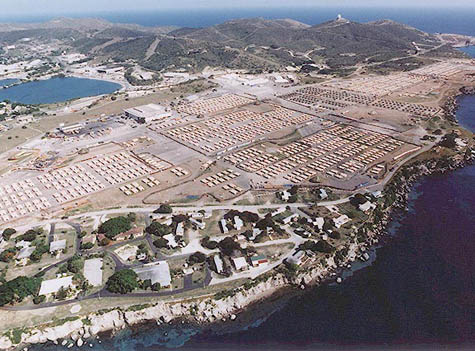 [Image: Airfield at Guantanamo Bay converted for the quarantine of 10,000 Haitian migrants; via Wikimedia].
[Image: Airfield at Guantanamo Bay converted for the quarantine of 10,000 Haitian migrants; via Wikimedia].Krista Maglen is Assistant Professor of History at Indiana University, where her research explores the nature of infectious disease prevention, including quarantine, during the latter part of the 19th century and beginning of the 20th century.
In her published work, which includes “‘In This Miserable Spot Called Quarantine’: The Healthy and Unhealthy in 19th Century Australian and Pacific Quarantine Stations” and “‘The First Line of Defense’: British Quarantine and the Port Sanitary Authorities in the 19th Century,” she focuses on the interrelationships between quarantine defenses, economic traditions, and medical restrictions on immigration.
As part of our ongoing series of quarantine-themed interviews, Nicola Twilley of Edible Geography and I spoke to Maglen about the ways in which different economic and cultural forces have shaped the practice of quarantine in Australia, the U.K., and the U.S.A. In this wide-ranging interview, we discuss the absence of a design philosophy for quarantine, quarantine’s potential for political misuse, and the differences between quarantine and other forms of incarceration.
Edible Geography: What led to your interest in quarantine?
Krista Maglen: My original interest was immigration, and I was looking at the way that immigrants had been restricted from coming into Britain for medical reasons. I had some assumptions about how that process occurred, but I realized it wasn’t as straightforward as in the U.S.A. or in Australia. When I looked a bit more deeply, I realized that this was because of the relationship that Britain had towards quarantine.
There is a long-standing opposition to quarantine in Britain, which meant that when Britain started to enact restrictions on immigration and immigrants, it was quite difficult, because those restrictions use many of the same mechanisms and much of the same language as quarantine. Both of them are designed to exclude certain groups of people, and they’re very closely interrelated.
That intersection between immigration and quarantine was where I began—and then I started to see all these amazing things about quarantine. It doesn’t only relate to medical and public health policy, or even just to immigration policy—it’s also very bound up with economic and political policy, as well. It is both shaped by, and a tool of, these larger geopolitical forces.
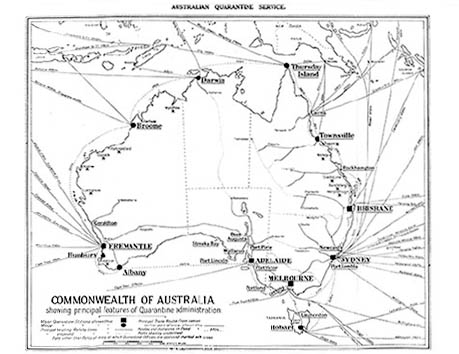 [Image: Map of the Australian Quarantine Service].
[Image: Map of the Australian Quarantine Service]. BLDGBLOG: I’m interested in your understanding of the relationship between quarantine and the construction of national borders.
Maglen: Quarantine differs very much depending on where a country is in relation to a disease source or perceived disease source. Australia, for example, has actually historically had one of the strictest quarantine policies, even though it’s so far away. Quarantine became a very big deal there. First of all, there’s a perceived proximity to Asia, which in the West has traditionally been seen as this great source of disease—the “Yellow Peril.” Quarantine is also a way to draw a line around White Australia, racially, just as much as it is to draw a line around the notion of a virgin territory that doesn’t have the diseases of the rest of the world.
Britain has a different relationship to quarantine because its borders are much more fluid. It can’t have borders as rigid as somewhere like Australia, for lots of different reasons: because of its empire; because it relies on maintaining open borders to let trade flow; and because Britain is itself quite undefined, in a way. It’s a composite of England, Ireland, Scotland, and Wales. The borders of Britain are much more fluid, so quarantine takes a different form there and has a very different history.
Edible Geography: You’re now based in the States, where I would assume quarantine is different again?
Maglen: Yes, exactly. Quarantine is closely tied to immigration in the United States: Ellis Island was a quarantine processing site, as well as an immigration processing site. Until the 1920s, immigrants arriving into the United States came into facilities that were also quarantine stations, and also places where you could isolate people for disease control reasons. Part of the processing of who can and can’t get into the United States is always about quarantine—what bodies are seen to be diseased and undesirable.
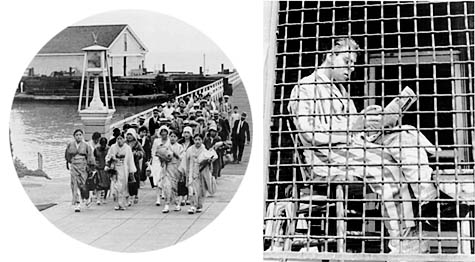 [Images: Asian immigrants arriving at the Angel Island immigration station, San Francisco, and a man quarantined at Ellis Island; courtesy of the National Library of Medicine].
[Images: Asian immigrants arriving at the Angel Island immigration station, San Francisco, and a man quarantined at Ellis Island; courtesy of the National Library of Medicine].Edible Geography: That raises an interesting question: By looking at a particular country’s quarantine regulations, can you construct in reverse what that country wishes it could be, or imagines it is?
Maglen: I think you can. Quarantine borders—just like national borders—are seeking to draw a line between us and them, inside and outside, desirable and undesirable, and so on. The United States is interesting because it has land borders as well as sea borders. The defining of a biological border, and its role in defining a national border, becomes more complex on land.
Edible Geography: Could you discuss the design of quarantine facilities and the way that also varied from country to country?
Maglen: When you’re thinking about quarantine, one really important thing to keep in mind is that there is a distinction between quarantine and isolation. Quarantine is a word that’s used quite freely. The way it’s used quite often now is to refer to the isolation of sick and infected people. But quarantine more accurately refers to the isolation of anyone who’s deemed to be a risk. That means that you can have perfectly healthy people in quarantine—and being held in quarantine for quite a long time.
One difference is that, in Australia, the quarantine facilities are designed to house all quarantined people—people who are sick and people who are healthy, but have either been in contact with an infected person or have come from somewhere that’s perceived to be an infected place. Australian quarantine stations have an isolation hospital—which is separated, but still part of the main facility—and then they have a big dormitory for all the healthy people who are having to be quarantined as well.
In Britain, the facilities that are set up are almost exclusively for the reception of sick and infected people. They’re really isolation facilities rather than quarantine facilities. Britain has a long history of taking the stance that quarantine is completely unnecessary, because you’re perfectly able to look after healthy people who may have been in contact with an infection if you have a public health system within the country, and that system works properly. From the 1870s or so onwards, Britain says that they’ve got the best sanitary system in the world, so they don’t need to worry about quarantine. Even today, there’s an argument made in Britain along very similar lines, which says that people arriving into Britain potentially carrying tuberculosis shouldn’t be excluded from the country or put into any type of isolation—they just need to be monitored within the National Health Service (NHS). The NHS, in this argument, has everything that is needed to control the spread of tuberculosis from immigrants to the population of Britain, so you don’t need to exclude immigrants on a medical basis.
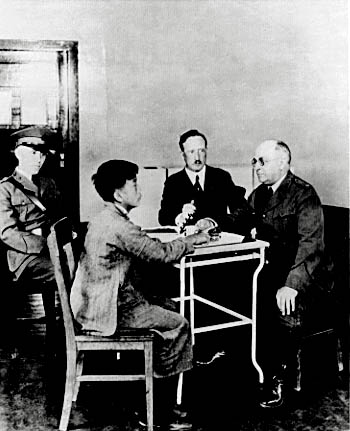 [Image: "Testing an Asian immigrant" at the Angel Island immigration station, San Francisco; courtesy of the National Library of Medicine].
[Image: "Testing an Asian immigrant" at the Angel Island immigration station, San Francisco; courtesy of the National Library of Medicine].BLDGBLOG: Does some of the difference in attitudes towards quarantine stem from different national political traditions and notions of individual human rights? For example, do the British have a stronger history of arguing for the right to resist involuntary government-imposed detention?
Maglen: It’s an interesting question but, in my research, I haven’t found much of that. Quarantine is much more closely tied to economic political traditions. Britain has a tradition of economic liberalism and free trade, which requires, to a great extent, open borders. Trade requires ships to come in and out, and those ships carry people.
Of course, discussions about human rights and individual liberty are a little bit beyond my period—but everywhere, even now, the argument is made that there are times and instances where individual liberty has to be given over to the greater good. Quarantine, in that argument, is just one of these instances where an individual’s liberty has to be curtailed in order to protect the broader community.
Something that was talked about a lot in the nineteenth century, and still now, is the difference between quarantine and other sorts of incarceration. Quarantined people might be perfectly healthy—they’re not necessarily physically or mentally ill—and they don’t really fit into the normal categories of people with reasons to be incarcerated.
What’s interesting about quarantine is that it assumes that people have the potential to cause harm without having to prove it; it presupposes guilt, in a way.
There’s a quotation from the Australasian Sanitary Conference in 1884 that I think captures a very important aspect of quarantine. It says, “Quarantine differs from a measure of criminal police in this respect: That it assumes every person to be capable of spreading disease until he has proven his incapacity; whereas the law assumes moral innocence until guilt is proven.”
Quarantine is really one of the singular instances in a liberal democracy where it’s possible for the state to incarcerate somebody without proven guilt. It’s a complete inversion.
What I’ve found in my research—which is focused on the nineteenth-century and early twentieth-century, so I can’t speak for today—is that most people who were quarantined agreed in principle with their incarceration and with quarantine. They believed that it was a just thing for them to be quarantined—in principle. They often talk about that at the very beginning of their period of quarantine. Once they’ve been placed into quarantine, it all seems quite different.
So, in theory, people believe in quarantine—but when you’ve been sitting for two months in a facility that often isn’t very well-equipped for people to live there, because they’re set up just for the occasions they might be needed, and often they’re not very nice or comfortable places to be, things seem very different.
One of the things that comes across consistently in people’s quarantine experiences is boredom. They complain about the accommodation and the food, and they get sick of the people they’re quarantined with—all those very normal human responses.
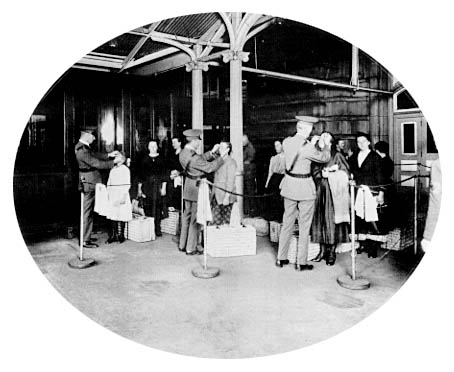 [Image: Medical inspection station at Ellis Island. The 1891 U.S. immigration law called for the exclusion of "all idiots, insane persons, paupers or persons likely to become public charges, persons suffering from a loathsome or dangerous contagious disease," as well as criminals. Courtesy of the National Library of Medicine].
[Image: Medical inspection station at Ellis Island. The 1891 U.S. immigration law called for the exclusion of "all idiots, insane persons, paupers or persons likely to become public charges, persons suffering from a loathsome or dangerous contagious disease," as well as criminals. Courtesy of the National Library of Medicine].Edible Geography: Following on from that, I’m interested in hearing more about your research into the experiences of the quarantined, but also about the experiences of those who were doing the quarantining. Are there recurring similarities or differences between those two points of view? And are there changes in the perception of their experience over time, or residual stigma, post-quarantine?
Maglen: The question about residual stigma is really interesting. My research hasn’t uncovered anything that reveals anything about that. If there was residual stigma, people aren’t talking about it. Not that I can find, in any case.
As I argue in my article, “In This Miserable Spot Called Quarantine,” it seems that quarantine is set up to deal with the singular problem of keeping people who are a potential risk away from the rest of the community. How that then works itself out in practice is really an afterthought. You put in place a facility, whether it’s on an island, a remote peninsula, or a huge moored boat, and you put in place the regulations that govern how a long a ship or people are supposed to stay in quarantine—but that’s about it. People are put there and forgotten about until it’s time for them to be released. Something that people who are being quarantined and people who work in quarantine both have in common is that most of them express great frustration at this.
It’s a “What do we now?” kind of thing: we’ve all got to sit around and wait, but there’s probably not sufficient accommodation for people, and we’ve been given these really crappy rations, and there’s no way of getting away from the other people held there.
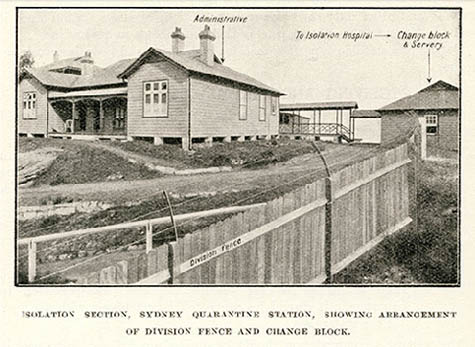 [Image: Isolation Section, Sydney Quarantine Station].
[Image: Isolation Section, Sydney Quarantine Station].Edible Geography: It’s as though the only design philosophy that exists for quarantine is keeping people away. You get a community that isn’t designed to function; it’s simply designed to contain. It’s a place that’s not designed as a place. It’s designed as a non-place.
Maglen: Exactly—that’s a perfect description. It’s designed as somewhere to deposit people temporarily—although, in some cases, that meant several months–but that’s about it. We just shut the doors and leave.
That’s what’s really great about reading the personal sources and stories of people who were in quarantine, because none of the official sources or government agencies see quarantine as anything other than a way to solve a problem. They don’t see it as individuals with their liberty being curtailed and their economic autonomy being frozen. They don’t see any of these problems; they’re just looking at the larger public health issue. It’s more of a macro view of disease control rather than a micro view of individual people’s lives.
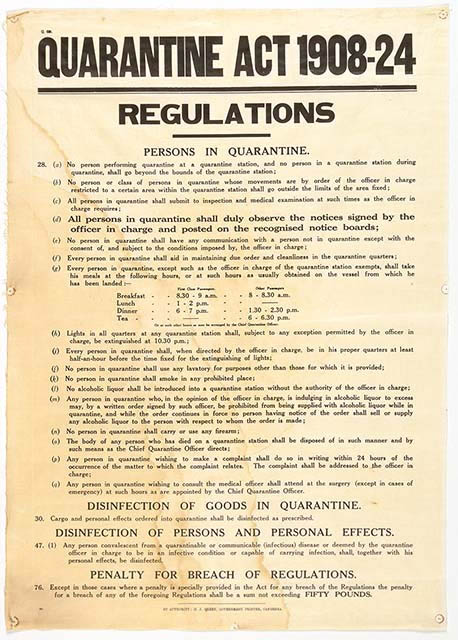 [Image: A "Quarantine Act" banner from the Torrens Island Quarantine Station collection, held by the National Museum of Australia, Canberra].
[Image: A "Quarantine Act" banner from the Torrens Island Quarantine Station collection, held by the National Museum of Australia, Canberra].BLDGBLOG: Talking about quarantine stations as a place simply to dump people reminds me of a bit of the architectural criticism of refugee camps. Refugee camps are often criticized as being nothing but utilitarian: built with no concern for community, culture, or how people will live once they’re placed there. Have you found other spatial types that are similar to quarantine facilities—whether that’s refugee camps or supermax prisons—where the same types of psychological and cultural issues emerge?
Maglen: Absolutely. The places I have studied that are similar are detention centers for asylum seekers in Australia.
There was a policy of mandatory detention for asylum seekers who arrived in Australia; they were put in horrible camps out in the middle of the desert until they could be processed. There was an assumption that if you were a “proper” refugee, you would have stayed in the refugee camps, in wherever it was that you were from, and waited until your application had been processed. You would have been given a visa saying that you were a refugee, and then you would have come to Australia on a plane and gone through the immigration line with the requisite stamp in your passport. This is obviously ridiculous—the life of a refugee doesn’t usually work that smoothly.
In any case, people who arrived in boats—or any way they could—in Australia and who didn’t have a refugee stamp in their passport—or a passport at all—were put in detention centers for long periods of time, sometimes years. The psychological problems that occurred amongst people who were isolated and detained in these places for that long were enormous. Not only were many of the people already psychologically damaged by the experiences that had led them to become asylum seekers and refugees, but they were then put into these temporary camps and isolated in the middle of nowhere.
The difference, however, between that example and people who have been put in quarantine, or people who are put in solitary confinement in prisons and so on, is that quarantine has a time limit. It’s limited, by definition—although, of course, it can be continued and extended. In fact, one of the problems of not setting quarantine facilities up properly is that you then get situations where poor design can lead to unnecessary extensions to the period of incarceration. So, for example, if I have been in quarantine for 15 days of a 20 day quarantine incarceration—with only 5 days left until I am released—and then you are newly placed in quarantine with me, if we are not adequately separated, I will have to start the 20 day quarantine period all over again—making my total quarantine 35 days. This is because I have been freshly exposed to a suspected disease source—you—and so my previous quarantine is rendered useless.
Quarantine facilities, therefore, need to be able to separate instances of exposure in order to avoid compounding the duration of incarceration. However, poor design of quarantine facilities—created essentially, as we said before, only to keep people away from the broader community and with little thought given to internal structures—has, at times, resulted in quarantines that have, unnecessarily, lasted for months.
Even so, there is always a limit with quarantine. First of all, epidemics only have a limited lifespan. Secondly, quarantine periods often have something to do with incubation periods, although the relationship is not as direct as you might think.
So, to speak to your question, I haven’t seen any long-term residual damage inflicted by quarantine, strictly as quarantine. When quarantine is strictly about disease, it doesn’t have the same kind of psychological effects, because you know that, in two months or so, you’re going to be let out. When quarantine is tied to other ideas, or when it becomes a way of keeping a particular class or race—or whatever category of people—outside, it quickly shades into something else.
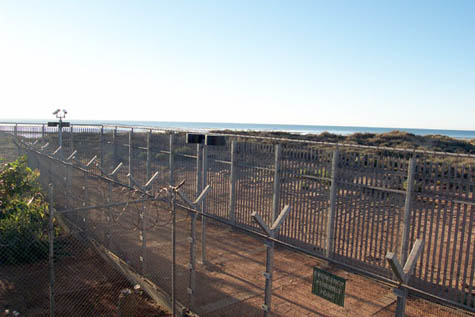 [Image: View through the perimeter fence at Port Hedland Immigration Reception and Processing Centre in Western Australia, June 2002, from the Australian Human Rights Commission].
[Image: View through the perimeter fence at Port Hedland Immigration Reception and Processing Centre in Western Australia, June 2002, from the Australian Human Rights Commission].Edible Geography: If quarantine has an end date, then surely it doesn’t actually function to exclude people from a country. In that case, is the point to use quarantine as a way of reinforcing prejudice and social hierarchies, so that people know their place, as it were, before they even come in the door?
Maglen: Quarantine can do that. It can also be designed as a way to dissuade people from wanting to try to come to your country in the first place. Quarantine is also very much about reaffirming models and stereotypes within the community: to create a feeling that “everybody knows that people from a particular country or region are dangerous, because look, the government has to quarantine everybody from there.” It gives a seemingly scientific backing for ethnic or racial prejudice.
An example of that is people from Haiti being quarantined by the United States at Guantanamo Bay, because of the risk of HIV and AIDS. You can read much more about this in Howard Markel’s book, When Germs Travel. There’s a really interesting chapter in there called “No One’s Idea of a Tropical Paradise: Haitian Immigrants and AIDS.” In it, Markel talks about how Haitian immigrants were being quarantined off-shore because they might be HIV-positive, and how that just re-confirmed—and put a government stamp on—prejudices against Haitians as being a dangerous and untrustworthy people.
That raises another very interesting point about quarantine: it can manipulate the public’s understanding of a particular disease. A disease might not be transmissible person-to-person, or it might not be highly contagious, but the imposition of quarantine automatically implies that there’s a person-to-person mode of infection (in the sense that, if I was sick and I stood in the same room and breathed on you, you would get sick). Quarantining people with HIV/AIDS implies that just coming into contact with them will expose you to infection.
Edible Geography: It seems, then, by virtue of being a practice of detention, quarantine can be misused very easily.
Maglen: Absolutely. It’s not just because it’s a practice of detention, but because quarantine, unlike isolation, is about keeping people who are deemed to pose a risk to public health separate. They’re not known to be a danger, but they’re judged to be a risk—and it’s that idea of risk that can be very easily manipulated. Risk could mean that they’re carrying a pathogen, or it could be that the place that person has come from is deemed to be diseased. It’s a very loose and dangerous term.
Edible Geography: What direction is your research taking now? Are you still exploring aspects of quarantine, or has it led you on to somewhere else?
Maglen: At the moment, I’m working on a book to develop my work on quarantine in Britain. I’m particularly looking at the border, and the idea of British ports being in-between spaces—spaces that are much more fluid than their American or Australian equivalents. I’m using that idea to examine the reasons behind the difficult relationship the British have with quarantine and immigration control, and also to explore how Britain sees itself within the United Kingdom and its former empire. I’m hoping to show how looking at immigration and quarantine can help us understand what’s happening in Britain as a nation and why it behaves as it does, both internally and internationally.
In the future, I want to continue looking at quarantine, but I want to move back to looking at Australia, and in particular, the Western Pacific. The French, British, and German imperial forces came in and tried to divide the islands up between them, even though the island populations had a long history of moving around in completely different patterns. I want to look at how disease control and quarantine were then used by the imperial powers as a way to control that movement of people.
This autumn in New York City, Edible Geography and BLDGBLOG have teamed up to lead an 8-week design studio focusing on the spatial implications of quarantine; you can read more about it here. For our studio participants, we have been assembling a coursepack full of original content and interviews—but we decided that we should make this material available to everyone so that even those people who are not in New York City, and not enrolled in the quarantine studio, can follow along, offer commentary, and even be inspired to pursue projects of their own.
For other interviews in our quarantine series, check out One Million Years of Isolation: An Interview with Abraham Van Luik, Isolation or Quarantine: An Interview with Dr. Georges Benjamin, Extraordinary Engineering Controls: An Interview with Jonathan Richmond, On the Other Side of Arrival: An Interview with David Barnes, The Last Town on Earth: An Interview with Thomas Mullen, and Biology at the Border: An Interview with Alison Bashford.
More interviews are forthcoming.





Comments are moderated.
If it's not spam, it will appear here shortly!
Something about the combination of the man in uniform the man with a Hitleresque stache and the interviewing "medical professional" really reminds me of a Nazi era concentration camp photo.
Interesting point/counterpoint
Thanks Geoff, it's a wonderfull interview
Post a Comment